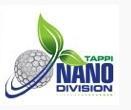Nathan Ellebracht awarded International Nanotechnology Division's Student Award
Jul 05, 2018 — Atlanta, GA

TAPPI Nano Division
Nathan Ellebracht, ChBE, and Gus Lang, MSE, both RBI Fellows, received awardes during the International Nanotechnology Division conference held recently in Madison, WI.
Ellebracht, also a member of the Jones Group, was awarded the International Nanotechnology Division’s Student Award for his research and contributions to the TAPPI Nano Division at the 2018 International Conference on Nanotechnology for Renewable Materials in Madison, Wisconsin.
His research focuses on new materials and products and his current research title is “Nanocellulose-based Cooperative Chemocatalysts for Conversion of Biomass-derived Furans to Fuels.”
Lang won top prize in the poster competition. His poster, titled "Robust paper-based electrochromic devices enabled by nanocellulose coated paper and chitin nanofiber barrier layers," was co-authored by Anna M. Österholm, Chinmay Satam, Carson Meredith, Robert J. Moon, and John R. Reynolds (who also serves as Lang's advisor).
The abstract is listed as follows: Utilizing cellulose paper as a substrate for electrochromic devices (ECDs) offers a route for developing next-generation, transient displays. However, attaining highly conducting, solution-processable electrodes on paper remains a challenge. Here, we achieve low resistance, inkjet-printed electrodes composed of poly(3,4-ethylenedioxythiophene):poly(styrene sulfonate) (PEDOT:PSS) with the use of a cellulose nanofiber coating on paper. This coating enhances ink retention on the surface resulting in a 1000x decrease in the electrode’s surface resistance. With this decreased resistance, the printed electrodes are capable of supporting the redox switching of various colored to clear electrochromic polymers thus providing access to the full color gamut which has not yet been demonstrated for paper-based devices. Lateral ECDs constructed on a single sheet of paper show a high degree of electrochemical stability, maintaining a high contrast and electroactivity after 9000 switching cycles in ambient environment. The electrochromic film stability to photo-oxidation is further extended with the addition of an oxygen barrier coating composed chitin nanofibers, cellulose nanocrystals, and polylactic acid. For disposal, the display pixel can be incinerated leaving just 10% of the initial mass as ash. This work highlights a route for incorporating nano-renewable materials in the construction of next generation optoelectronic devices with low environmental impact.
TAPPI’s International Nanotechnology Division was launched in 2011 as a new division within TAPPI after several years as a large committee. TAPPI, the leading technical association from professionals in the pulp, paper, packaging, tissue and allied industries, has eleven divisions representing the various markets it serves. TAPPI’s NanoDivision is a forum for scientists, technical professionals, students and other stakeholders interested in advancing the responsible and sustainable production and use of renewable nanomaterials.
Ellenbracht is co-chair of the NanoDivision Student Committee, along with another Georgia Tech RBI Fellow, Bailey Risteen.




